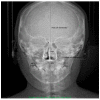Safety and Effects of the Rapid Maxillary Expander on Temporomandibular Joint in Subjects Affected by Juvenile Idiopathic Arthritis: A Retrospective Study
- PMID: 33430404
- PMCID: PMC7827492
- DOI: 10.3390/children8010033
Safety and Effects of the Rapid Maxillary Expander on Temporomandibular Joint in Subjects Affected by Juvenile Idiopathic Arthritis: A Retrospective Study
Abstract
Background: In Juvenile Idiopathic Arthritis (JIA) temporo-mandibular joints are often affected causing skeletal and dental malocclusions. The most frequent condition is mandibular hypoplasia, that may be associated with maxillary hypoplasia. The aim of this retrospective case control study is to investigate the effects and the safety of rapid maxillary expansion (RME) in growing patients affected by JIA. It was evaluated whether RME could be performed without complications on TMJs of JIA patients using DC/TMD protocol, and naso-maxillary transversal parameters were compared with the ones obtained on healthy patients.
Methods: Twenty-five patients affected by JIA that ceased to manifest TMJ (Temporo-Mandibular Joint) symptoms in the previous year were treated with RME to solve the maxillary transverse hypoplasia. Postero-anterior cephalometric tracings were collected before and after treatment; linear measurements were obtained to study maxillary and nasal cavity modifications. Data were compared to those of a similar group of twenty-five healthy patients. Paired t-test and Independent t-test were used to evaluate changes before and after treatment in each group and to perform a comparison between the groups.
Results: All patients demonstrated a statistically significant increase in nasal cavity width, maxillary width and upper and lower intermolar width. No patients presented a worsening of their TMJs condition. Intragroup comparisons revealed significant changes of cephalometric measurements, but no difference was found when comparing JIA and healthy patients.
Conclusions: Growing patients with JIA that ceased to show signs of active TMJ involvement for at least one year could be safely treated with RME, expecting similar benefits to those of healthy patients. Dentists and rheumatologists should be informed of safety and potential benefits of palatal expansion in JIA patients in order to improve the outcome of orthodontic treatment and reduce the indication for more invasive procedures (i.e., Surgical Assisted Rapid Maxillary Expansion).
Keywords: juvenile idiopathic arthritis; maxillary hypoplasia; rapid maxillary expansion; temporomandibular joint arthritis.
Conflict of interest statement
The authors declare no conflict of interest.
Figures
Similar articles
-
Effects on the Facial Growth of Rapid Palatal Expansion in Growing Patients Affected by Juvenile Idiopathic Arthritis with Monolateral Involvement of the Temporomandibular Joints: A Case-Control Study on Posteroanterior and Lateral Cephalograms.J Clin Med. 2020 Apr 18;9(4):1159. doi: 10.3390/jcm9041159. J Clin Med. 2020. PMID: 32325675 Free PMC article.
-
Comparison of the skeletal, dentoalveolar, and periodontal changes after Ni-Ti leaf spring expander and rapid maxillary expansion: a three-dimensional CBCT based evaluation.Clin Oral Investig. 2023 Sep;27(9):5249-5262. doi: 10.1007/s00784-023-05144-6. Epub 2023 Jul 19. Clin Oral Investig. 2023. PMID: 37466717 Free PMC article.
-
Prevalence of temporomandibular disorder in children and adolescents with juvenile idiopathic arthritis - a Norwegian cross- sectional multicentre study.BMC Oral Health. 2020 Oct 13;20(1):282. doi: 10.1186/s12903-020-01234-z. BMC Oral Health. 2020. PMID: 33050890 Free PMC article.
-
Spontaneous Mandibular Dentoalveolar Changes after Rapid Maxillary Expansion (RME), Slow Maxillary Expansion (SME), and Leaf Expander-A Systematic Review.Children (Basel). 2024 Apr 22;11(4):501. doi: 10.3390/children11040501. Children (Basel). 2024. PMID: 38671718 Free PMC article. Review.
-
Oral health and orthodontic considerations in children with juvenile idiopathic arthritis: review of the literature and report of a case.J Ir Dent Assoc. 2008 Feb-Mar;54(1):29-36. J Ir Dent Assoc. 2008. PMID: 18405212 Review.
Cited by
-
Relationship between Tooth Loss and the Medications Used for the Treatment of Rheumatoid Arthritis in Japanese Patients with Rheumatoid Arthritis: A Cross-Sectional Study.J Clin Med. 2021 Feb 20;10(4):876. doi: 10.3390/jcm10040876. J Clin Med. 2021. PMID: 33672719 Free PMC article.
-
Changes in the Mandible Following Rapid Maxillary Expansion in Children with Class II Malocclusion: A Systematic Review.Diagnostics (Basel). 2022 Jul 11;12(7):1688. doi: 10.3390/diagnostics12071688. Diagnostics (Basel). 2022. PMID: 35885592 Free PMC article. Review.
-
Is Augmented Reality Technology Effective in Locating the Apex of Teeth Undergoing Apicoectomy Procedures?J Pers Med. 2024 Jan 7;14(1):73. doi: 10.3390/jpm14010073. J Pers Med. 2024. PMID: 38248774 Free PMC article.
-
Cone-Beam Computed Tomography (CBCT) Analysis of Mandibular Condyles' Diameters in Patient with Juvenile Idiopathic Arthritis and Temporomandibular Joint Affection: A Cross-Sectional Investigation.J Clin Med. 2024 Aug 28;13(17):5104. doi: 10.3390/jcm13175104. J Clin Med. 2024. PMID: 39274322 Free PMC article.
-
Posterior Mandibular Displacement-A Systematic Review Based on Animal Studies.Animals (Basel). 2021 Mar 15;11(3):823. doi: 10.3390/ani11030823. Animals (Basel). 2021. PMID: 33804016 Free PMC article. Review.
References
-
- Ugolini A., Doldo T., Huanca Ghislanzoni L.T., Mapelli A., Giorgetti R., Sforza C., Fastuca R., Lorusso P., Lagravère M.O., Michelotti A., et al. Dentoskeletal outcomes of a rapid maxillary expander with differential opening in patients with bilateral cleft lip and palate: A prospective clinical trial. Am. J. Orthod. Dentofac. Orthop. 2017;17:1–7. doi: 10.1016/j.ajodo.2014.09.014. - DOI
-
- Müller L., Kellenberger C.J., Cannizzaro E., Ettlin D., Schraner T., Bolt I.B., Peltomäki T., Saurenmann R.K. Early diagnosis of temporomandibular joint involvement in juvenile idiopathic arthritis: A pilot study comparing clinical examination and ultrasound to magnetic resonance imaging. Rheumatology. 2009 doi: 10.1093/rheumatology/kep068. - DOI - PMC - PubMed
-
- Maspero C., Cavagnetto D., Abate A., Cressoni P., Farronato M. Effects on the Facial Growth of Rapid Palatal Expansion in Growing Patients Affected by Juvenile Idiopathic Arthritis with Monolateral Involvement of the Temporomandibular Joints: A Case-Control Study on Posteroanterior and Lateral Cephalograms. J. Clin. Med. 2020;9:1159. doi: 10.3390/jcm9041159. - DOI - PMC - PubMed
LinkOut - more resources
Full Text Sources
Other Literature Sources



